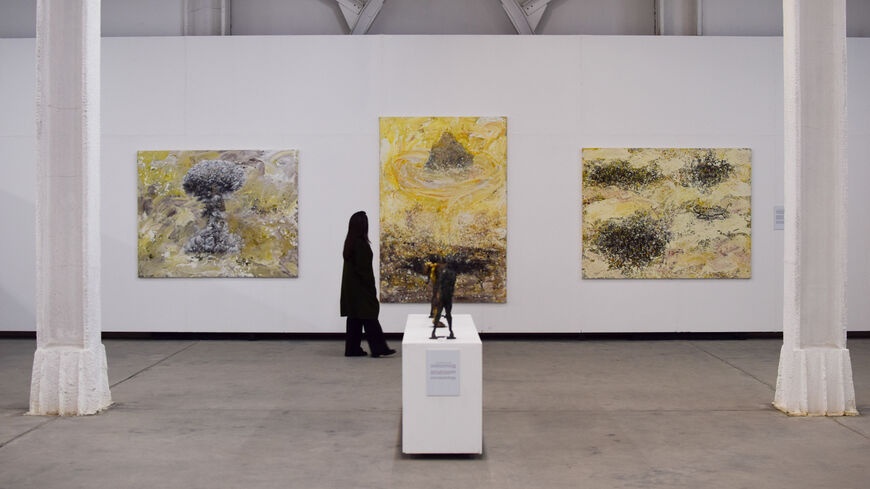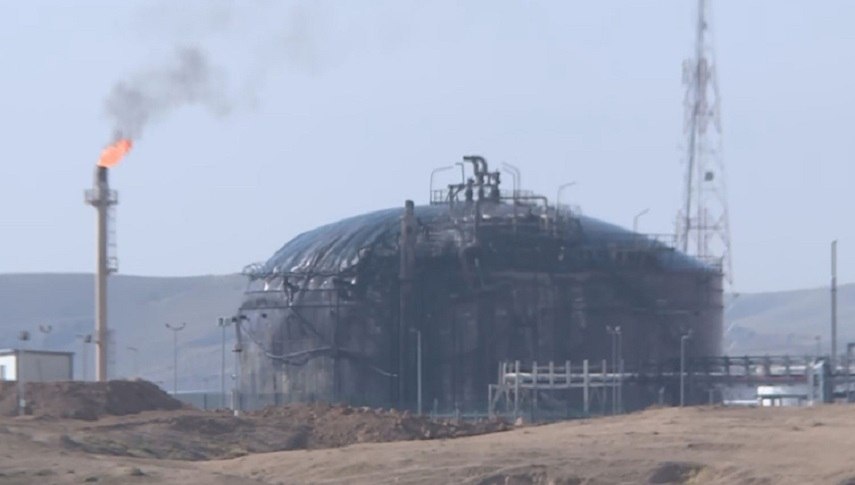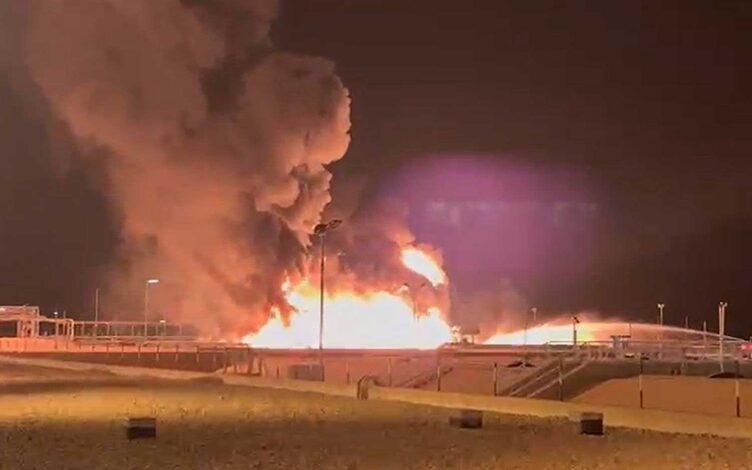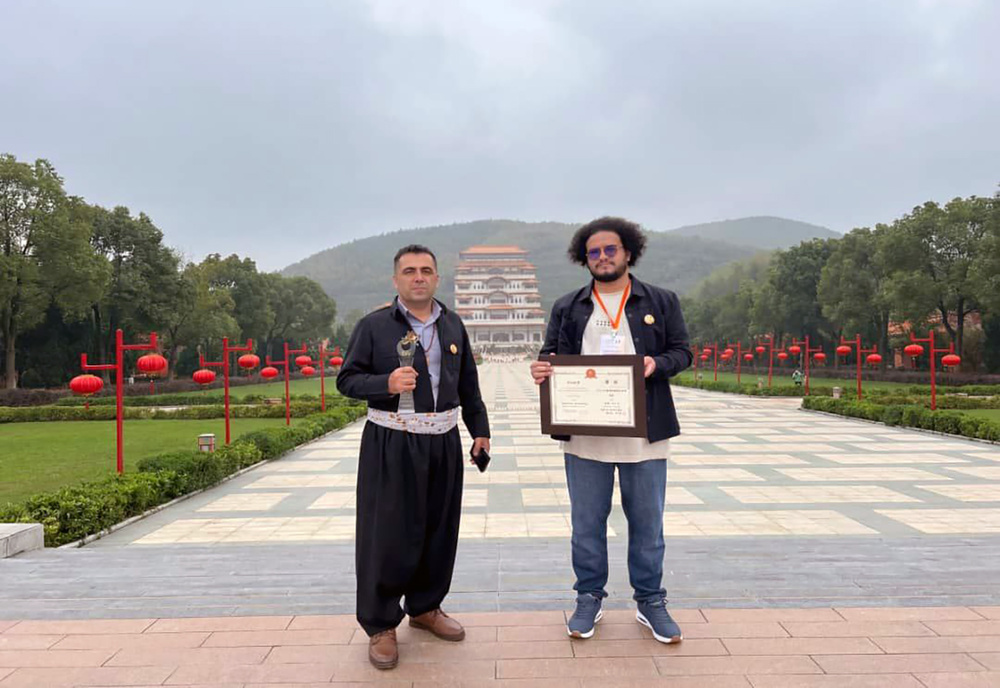Abdullah plugs in a small space heater to ward off the winter chill in the industrial cavern, apologizing about the mess of electrical wires, sound cables and paint cans strewn about, left over from her most recent project.
“It’s my dream place,” she said of her studio, where she has worked for the past 10 years. “Everything I’ve ever made here, it’s all part of a big web that helps create the new artwork I’m trying to do.”
Sulaimaniyah is frequently referred to as the Kurdistan Region of Iraq’s “culture capital” and is a young city by regional standards. It was founded in 1784 and has attracted poets, musicians, merchants and political activists ever since. In 2019, it was designated a UNESCO City of Literature. Its warrenous bazaar and park-studded downtown feel alive and timeless compared with the ersatz Dubai under construction in Erbil, the Kurdistan Region’s political capital.
The city also serves as a base for painters, sculptors and graphic artists who take advantage of the growing infrastructure of galleries, studios and training programs where they can hone their craft and exhibit their work.
“It’s exciting,” said Shirwan Can, an artist and founder of Paia Agency, a social entrepreneurship network. “For contemporary art, compared with the rest of Iraq, Sulaimaniyah is the best … and the scene is growing because there are many young people and activities.”
Nevertheless, artists in the city must contend with significant challenges, including a lack of engagement from the general public, difficulty in securing funding and outright hostility from more conservative elements of society.
Despite the city’s reputation as a cultural center, there is an inescapable feeling within the art community of distance from ordinary people that limits the impact of their work.
“If the public is not interested in our product, then why is the artist important?” Can asked.
Some progress has been made in recent years, however. In 2019, an initiative called the Culture Factory, or Karge Kultur in Kurdish, opened on the sprawling tobacco factory site.
It was a battle to realize the project, located on a tract of extremely valuable real estate in the city’s downtown that is coveted by commercial developers. Today, it offers studio space and apprentice programs in fashion design, jewelry making and sculpture.
Dara R. Ola, known as Daro, is the founder and organizer of Esta Gallery, an exhibition space of the quality found in European capitals, located in the tobacco factory several floors below Abdullah’s studio. He said he's very optimistic that the gap with the public can be bridged.
“Always, fine art is a little bit far from the public, but now we are trying to bring each other together,” Daro said, adding that more than 8,000 people went to the most recent show, including field trips from 56 local schools.
“Before, we always contacted schools to tell the teachers to bring the students to us, but now every day they are coming themselves,” he said proudly.
Can’s Paia Agency is also building out a new space, turning an old indoor pool in the city’s Sarchinar neighborhood into an exhibition, performance and community center. One studio is devoted to the production of new graphic novels. An environmental youth group was using it to prepare for a kayaking trip when Al-Monitor visited.
Some artists address this perceived distance with the public head-on through their choice of medium and subject.
Abdullah’s most recent project was an installation set up in public spaces in Sulaimaniyah and the outlying cities of Ranya, Halabja and Chamchamal that broadcast recordings of a female voice describing the hardships faced by women and girls in Kurdish society, a subject she has explored in the past.
“I want my art to engage with my father, who is a construction worker, and my mother, who always stays at home, with members of the general public,” she said. “It’s not only for other artists.”
However, there is much work to be done to bridge this gap.
Sulaimaniyah lacks a general idea of "what art should be," said artist Rebeen Hamarafiq. “Some neighborhoods don’t have even one exhibition in 10 years. How can you expect people to understand culture?”
Even more optimistic voices encourage such criticism.
“We’re critical because we want more and more to make Sulaimaniyah the perfect space for art,” Daro said.
Another major concern for artists is the availability of funding for their projects. While some local sources of support exist, funding from foreign governments and nongovernmental groups plays a large role.
For example, the Goethe Institute and the Institut Français both provide support for artists and exhibitions in the Kurdistan Region, but often the money is drawn from funds to support distinct policy aims, which have to be built into the artists’ designs and can distract from their original vision.
“They have funds for peace building and women’s projects. So we don’t make what we want; we make a project for what the funder wants. This is a bad influence on the culture scene,” said Can.
Local support is limited to a small circle of philanthropists and figures connected with the ruling political parties in the Kurdistan Region, the Patriotic Union of Kurdistan in Sulaimaniyah and the Kurdistan Democratic Party in Erbil.
The artists had mixed feelings about support for their projects from partisan sources, fearful of being co-opted into a political project over which they have little control.
“Artists don’t get support for being different or democratic, only for specific purposes. This decreases the authority of art, which is for criticizing daily issues rather than serving a political ideology,” Hamarafiq said.
Party funding was also viewed as a narrow base on which to build Sulaimaniyah into the vibrant and self-sustaining artistic center they envision.
“The parties are now a client for art. But if you create an art industry, artists don’t have to go to the parties for funding,” Can said.
Beyond these challenges, artists in Sulaimaniyah have to contend with opposition to their work from religious conservatives, who have become increasingly vocal in the Kurdistan Region and use criticism of artistic endeavors to whip up support.
Abdullah’s recent installation about violence against women was quickly shut down by the local security forces after complaints.
“The project faced a significant backlash from certain members of society, particularly male-dominated and Islamic communities. These groups claimed that the project's message was hateful toward Islam and supportive of the LGBTQ community,” Abdullah said.
“However, the project actually focused on violence against women and women's rights and had no intention of criticizing Islam. This incident highlights the complexity and sensitivity of art projects that tackle controversial topics,” she added.
In her studio, amid the remnants of the intense effort that went into her last project — put to an end just as it was starting — Abdullah is figuring out what to do next.
“Despite all the criticism, I keep doing this because it is what represents me.”
Al-Monitor
Reporter's code: 50101







Your Comment